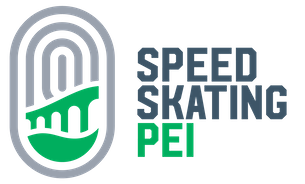Standard Safety Practices On and Off the Ice
There is a certain amount of risk involved in any sport. However, these risks can be minimized by adherence to general and specific safety practices. In order to ensure the safest possible environment for skaters, coaches, and volunteers, Speed Skate PEI has established a set of Standard Safety Practices. It is expected that all skaters, coaches, volunteers, and parents will support and adhere to these practices. These practices will be reviewed on a regular basis by the Speed Skate PEI Executive and updated as required.
1. No skater is allowed on the ice during practice or competition without the appropriate safety gear. As dictated by the regulations of the sport, this includes at a minimum an appropriate helmet worn correctly, shatter resistant eye protection, a bib-style neckguard of appropriate cut-resistant material (dyneema or kevlar), cut-resistant and water-resistant gloves (no knit or fold-back gloves), knee protection, soccer-style shin-guards (optional for Learn to Skate) and kevlar or dyneema ankle guards. Additional safety gear that is recommended but not required includes elbow pads (particularly for young skaters) a mouthguard, and cut-proof skin suit. In recent years, cut-proof skin suits have become the norm for all competitive skaters. All eyewear must be held on securely with a strap. Long-sleeve clothing must be worn at all times and all skin from the neck down must be covered at all times.
2. Skaters (children, parents, or assistants) can not enter the ice surface until the Zamboni is completely off the ice and a coach has given permission to enter the ice surface. In essence, this means that unless a coach is present and on the ice, no skater is to enter the ice surface. Skaters are only to enter the ice from the dressing room side of the ice through the player’s bench doors.
3. No skaters are to skate on the track (Learn to Speed Skate and higher programs) unless the appropriate mat protection is in place. Single board mats extending from two mats past the blue line to fully around the end boards are required for Learn to Speed Skate and Speed Skating 2 practices. For Competitive practices, padding is required from just short of the center red line and fully around the end boards. There must be double padding for most of this length. Coaches will know the specific padding setup for their group. In all cases, velcro must hold the mats securely in place.
4. No skating on the track (at any speed) is allowed while mats are being put up or taken down.
5. Parents and skaters should avoid walking on “fresh” ice with street shoes as it puts dirt on the ice that can easily harm the sharpness of blades and thus jeopardize the safety of the skaters. Ideally, we will place the mats before the zamboni cleans the ice surface before a practice. This makes it less slippery for those placing the mats and allows the zamboni to pick up any dirt particles (e.g. from footwear) before skaters enter the ice surface for their practice. If walking on clean ice is necessary, please stay on the perimeter of the ice surface (i.e., as close to the boards/mats as possible). Avoid walking “across” the ice surface with mats during set-up; please carry mats along the boards. Even a tiny piece of dirt can ruin the edge of a skate and (for competitive skaters) end their practice! Skaters assisting with mat placement before the zamboni has cleared the ice should wear regular footwear rather than skates.
6. The Coaches have control of the ice surface and dictate when skaters are allowed on the track or on the ice surface. They may have a skater temporarily or permanently leave the ice surface during a practice if their behaviour is interfering with the practice or jeopardizing the safety or enjoyment of other skaters. This includes rough play, dangerous skating on the track, or skating around in center ice when instructed not to, swearing or cursing, gesticulating rudely or angrily or being uncooperative with coaches.
7. Skaters are not to lean on the rink boards while other skaters are on the track nor are they to cross the track. In general, water bottles should be kept at centre ice to minimize crossing the track.
8. Skaters may not exit or enter the ice surface while skaters are on the track and then only with permission of the coach. In general, leaving and entering the ice surface during practice is not encouraged. Skaters must be on time for practice as entering the ice during practice can create situations where skaters may collide and interrupt practice.
9. Coaches are responsible for monitoring the number and speed of skaters on the track. They are responsible for ensuring that the number and range of speed of skaters on the track at any time respects the safety of the skaters.
10. A first aid kit should be available at all times during practices or competitions. In case of emergency, a parent is requested to phone 911 at the direction of a coach on the ice surface.
11. Parents are requested not to leave children under the age of 16 unattended at the rink unless they have notified the coach and identified another parent to take responsibility for the skater in case of injury.
12. The City of Charlottetown has a by-law that anyone who is on the ice surface must be wearing a helmet. This by-law applies to parents who are assisting on ice with the placement or removal of safety mats. SSPEI has several helmets available for use that are stored with the safety mats.
